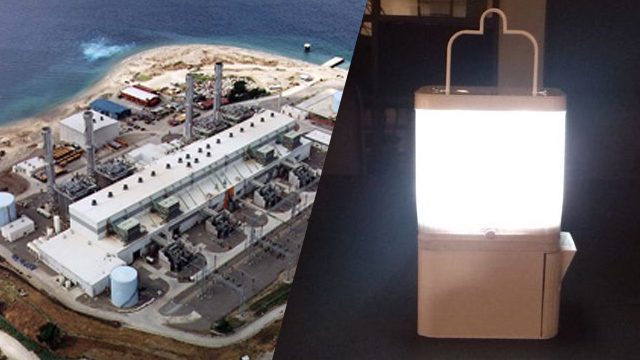SUMMARY
This is AI generated summarization, which may have errors. For context, always refer to the full article.

MANILA, Philippines – Senate President Pro-Tempore Ralph Recto said the government should bankroll the development and mass production of the Sustainable Alternative Lighting or SALt lamps by using idle funds, like the P168.9 billion ($3.59 billion) Malampaya gas royalties.
Recto was referring to the government share from the production of the Malampaya natural gas field off the coast of Northern Palawan. (READ: COA tags 5 gov’t agencies in Malampaya fund scam)
“If you look at government finances, there should be no problem in finding money for these saltwater lamps,” Recto said in a statement released Tuesday, November 24.
The senator added the SALt project would qualify for Malampaya funding under Presidential Decree No. 910, which states that government share from the exploitation of energy resources can be used to finance energy programs.
SALt’s co-founder and engineer Aisa Mijeno was featured in a panel moderated by US President Barack Obama on November 18 during the Asia-Pacific Economic Cooperation (APEC) Summit in Manila. (READ: Filipina startup founder shares stage with Obama, Jack Ma)
In that panel, Mijeno shared they need support so SALt can mass produce the SALt lamp that uses saline solution or seawater to power up a LED lamp, and can even charge mobile phones with a USB portal.
Hearing this, Obama pointed to Jack Ma, the Chinese billionaire founder of e-commerce Alibaba. Later, Ma offered to mentor Mijeno. (READ: Alibaba’s Jack Ma offers to mentor Filipina engineer)
Use idle funds
For Recto, the government has idle funds like the Malampaya royalties to bankroll the development and mass production of SALt lamps.
One saline solution-powered lamp, which can produce up to 90 lumens of light, is said to cost $20, plus $3 every 6 months for the replacement anode.
“If reports are true that P20 million ($425,061.27) is what the developers initially need to jumpstart the lamp’s production, then just 6 hours’ worth of Malampaya would be enough,” Recto said.
He added that there is even no need to seek budget from the Congress because some of these funds are off-budget, “meaning, they can be tapped without having to go through the annual appropriations route, like the Malampaya royalty remittances.”
The Malampaya fund posted an outstanding balance of P168.9 billion ($3.59 billion) as of May 31, 2015.
Since 2002, government has received a total of P210.9 billion ($4.48 million) from the production well’s operator.
Releases from this fund reached P42 billion ($892.55 million), Recto said, citing an official Bureau of Treasury report.
Next year, Malampaya remittances are projected to hit P34.7 billion ($737.40 million).
“This means on a daily basis, Malampaya is pumping P91.7 million ($1.95 million) into the government coffers,” Recto said.
The Malampaya consortium remitted $900 million in royalty payment to the national government last year. Total payment turned over to the government amounted to $8.5 billion since the commissioning of the project in 2001.
The Malampaya gas project supplies 40% of Luzon’s energy needs by fueling 3 natural gas power plants with a combined capacity of 2,700 megawatts (MW). SPEX wants the energy department to extend its license to operate the gas field for 15 years. (READ: Malampaya consortium seeking extension until 2039)
“Government’s daily windfall alone is more than enough to finance the development of SALt’s full potential,” Recto said.
Gov’t venture with SALt?
Recto said the government should approach Mijeno and offer her “joint venture engagements.”
“Lack of funds cannot be invoked as a reason because clearly they’re available,” he said.
Apart from Malampaya proceeds, Recto said the Department of Science and Technlogy’s (DOST) P19.1 billion ($405.89 million) budget for 2016 features “grants to technology startups, assistance to inventors.”
Recto added the Senate has called the attention of the DOST “to immediately reach out to Mijeno for the possibility of her project being given support.”
In an ABS-CBN report on November 23, DOST denied that it snubbed Mijeno and explained that she was part of IdeaSpace, a group that supports entrepreneurs and innovators, and which DOST has already a tie-in.
DOST Assistant Secretary Raymund Liboro added the agency’s Technology Application and Promotion Institute (TAPI) has already been in touch with Mijeno even before the APEC summit in Manila.
The Department of Energy (DOE), meanwhile, will also receive P2.84 billion ($60.37 million) to bring electricity to 3,150 hard-to-reach households, according to a Department of Budget Management (DBM) briefer.
On top of this, the DOE would also energize 5,400 households in off-grid areas, a government effort wherein Mijeno’s SALt can help, Recto said. – Rappler.com
Add a comment
How does this make you feel?
There are no comments yet. Add your comment to start the conversation.